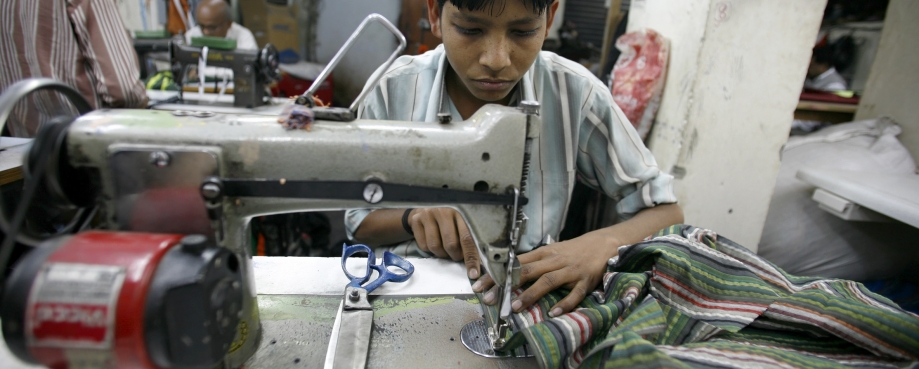
- The four stages in effectively managing the risk of child labour.
- The 11 indicators of modern slavery and how to deal with them.
“Finding either child labour or modern slavery in the supply chain are two of the biggest reputational risks that any company will ever face,” said Ethical Trading Initiative spokesperson, Cindy Berman.
As such, ETI is today releasing two free business guidance manuals on Child Labour and on Modern Slavery.
The manuals include advice to help companies develop a deeper understanding of key concepts and legal responsibilities. Importantly, they also list tools, tips and techniques for reducing and mitigating risk.
Child labour guidance
ETI’s child labour guidance sets out four stages in effectively managing the risk of child labour.
Companies are told how to:
- Assess the actual and potential risk of child labour.
- Identify their corporate leverage and responsibility – and the decision-making and actions that are necessary.
- Mitigate risk and remediation in cases where violations of standards are found.
- Monitor implementation and impact to ensure that the best interests of children are at the forefront of any action taken.
“Understanding and addressing child labour can be a minefield for companies,” said Cindy Berman.
She continued: “Universally agreed and legally binding rights of the child are enshrined by the UN. Yet, while international standards are clear the reality in countries is too often different.”
Depending on a country’s development status, the age that a child can officially start working full time may be as young as 14, and 13 for part-time work.
However, ETI regards the lower age range for full-time work as unacceptable.
When negotiating with suppliers, ETI is advising companies to set clear red lines that are consistent with its Base Code of labour practices and the highest international standards.
Cindy Berman said: “Child labour is a business-critical issue and addressing it is essential for a company’s credibility and legitimacy.”
Modern slavery guidance (published with Anti-Slavery International)
With 80% of those working as slaves found in the commercial sector, ETI and Anti-Slavery International strongly advise companies to proactively look for 11 indicators of forced labour.
The indicators include, but are not limited to, retention of identity papers, withholding wages, abusive living and working conditions and restriction of movement.
Originally identified by the International Labour Organisation, a single indicator when taken on its own may not constitute slave labour. But, ETI and Anti-Slavery International believe, that when several are present they almost certainly do.
“The statistics are stark,” said Cindy Berman. “Not only is modern slavery a predominantly business issue, companies recognise it as such. Well over three-quarters believe that there is a likelihood of modern slavery occurring in their supply chains.”
The guidance not only lists the indicators but goes further by outlining what to look for within each indicator as well as cataloguing mitigation strategies.
Cindy Berman said: “It is important that companies exercise their leverage to reduce the risk of slavery in supply chains and influence suppliers’ employment practices. But they can only do this if they know what to look for and how to end exploitation.”
ENDS
Released by Jane Moyo, Ethical Trading Initiative, External Relations team | jane.moyo@eti.org.uk | +44 (0)207 841 4350 or +44 (0)7972 053624
Notes
- Child labour: Universally agreed and legally binding rights are enshrined in the United Nations Convention on the Rights of the Child with the Convention defining a child as everyone under 18. ILO Convention 138 specifies the minimum age that anyone can be employed in full-time work as 15, with binding standards over the type of work children can do. However, in some countries age limits are set are higher while in others they can be as low as 14, depending on development status. ILO Convention 182 defines the “worst forms of child labour” and includes work that is hazardous, undertaken at night, requires long hours or causes harm to health safety or morals. It sets an absolute age limit of 18 for these types of work in all countries.
- The 11 indicators of modern slavery are: 1) Abuse of workers’ vulnerability; 2) Deception; 3) Restriction of movement; 4) Isolation; 5) Physical or sexual violence; 6) Intimidation and threats; 7) Retention of identity documents; 8) Withholding wages; 9) Debt bondage; 10) Abusive living and working conditions; 11) Excessive overtime.
- Modern slavery: Modern slavery is an umbrella term that includes forced labour, debt bondage, servitude and trafficking for the purposes of labour exploitation. The prohibition of forced labour forms Clause 1 of ETI’s Base Code of labour standards, Employment is freely chosen, as it is viewed as the worst possible labour rights violation. Forced labour describes a situation in which a worker performs work or services involuntarily under threat of penalty.
Download our new child labour and modern slavery base code guidance.
The image of a young Indian worker is for illustrative purposes only and is not necessarily indicative of either child or forced labour
